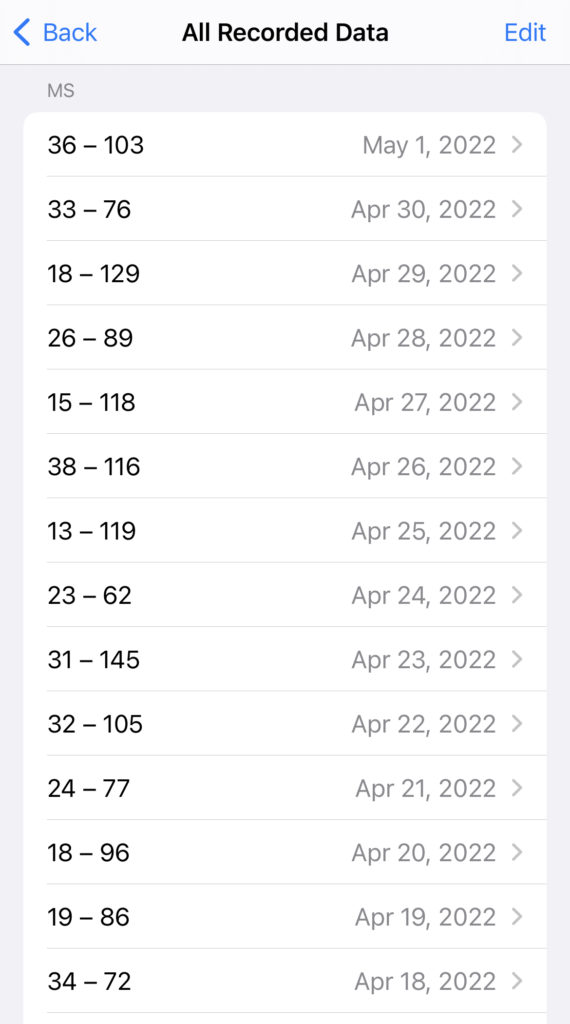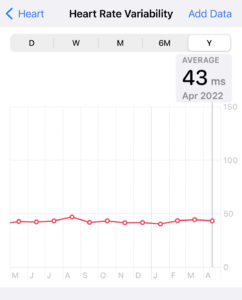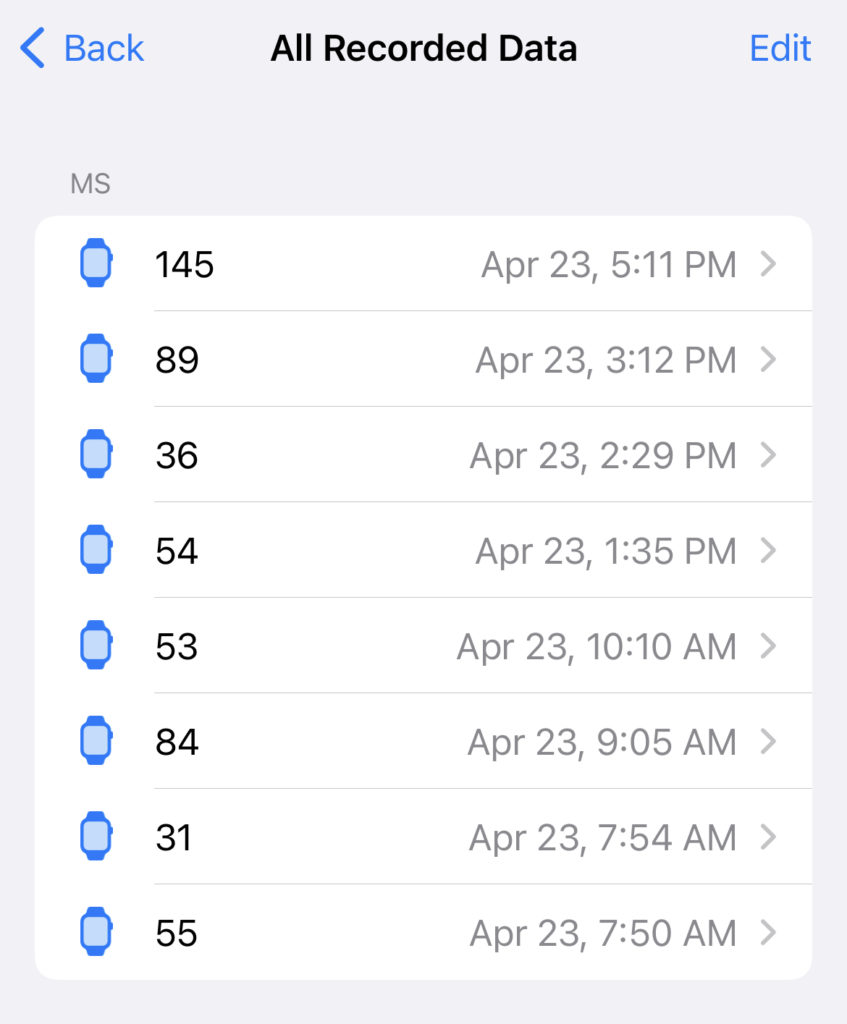If you have an Apple Watch and look at your health app ever, you have probably noticed the Heart Rate Variability. Compared to resting heart rate and a current heart rate, the heart rate variability (HRV) measure is much less common of a marker about health. Recently though it has been used by a variety of fitness apps to indicate how stressed you might be (either from training or just life!).
So what is this HRV measurement, can you learn anything from it, and how accurate is Apple Watch when measuring heart rate variability? We dive in with this article to find out how you can learn more about your health from this metric.
Is Apple Heart Rate Variability Accurate?
Some people argue that the sensor on Apple Watch can not get an accurate heart rate variability reading. That is not true, and there are peer reviewed studies showing reliable and accurate Apple heart rate variability measurement, but that doesn’t mean the readings are all great.
Generally speaking the Apple Watch heart rate variability is 90% accurate. This means it can somewhat correlate to being overly stressed if taken under the same conditions every day. It is important to know though that HRV is measured over a very short period of time and will vary widely throughout the day.
A reader pointed out our original referenced study was of dubious quality. The study original cited, and the current one, both have limited participants and only validate measurements in lab controlled settings. Still, both anecdotal evidence and studies suggest that when you are overly stressed it will show up with a low overall HRV.
Real world use is different, as is the reporting. One major issue to take into account is which readings are being used and displayed.

The Watch, if worn throughout the day, will take multiple heart rate variability readings. You can force a reading by using the breath app or the workout app. Both should create a heart rate variability reading unless there is a consistency issue with the heart rate sensor.
That said through the course of a day this reading can vary widely. After a workout you are knowingly under stress, while a breathe session might be near your resting heart rate. Comparing the twice, or averaging them, shows an incomplete view. For example, at rest it is possible to get a variability reading of 200ms+. This would be nearly impossible to reach when at peak heart rate since at 150BPM a single beat is only 400ms.
What is HRV Good For?
Heart rate variability, as measured by Apple Watch, Whoop, and other fitness trackers, will be lower when your body has been stressed. This happens when you over train, sleep poorly, drink alcohol, or experience stress life situations.
The definition of HRV as stated by Harvard Health, is “a measure of the variation in time between each heartbeat.” Academic journals expand on this saying that the HRV measures changes in time intervals between interbeat intervals (IBIs) of consecutive heartbeats. It is an indicator of how resilient your heart is to changes and a proxy for heart health and stress levels.
If you have watched any movies or shows where a heart rate monitor shows up it may seem like the heart beat is a uniform pattern, but there are minor fluctuations in that rhythmic sound. It is dictated by a combination of your brain and nervous system and is influenced by everything from your diet and environment to sleep and external stressors. Because it touches on such an important part of the body, the heart, and because there are some many critical processes that can influence it changes in heart rate variability can be linked to a huge variety of wellness and health issues.
Generally speaking a better HRV measurement equates to less fatigue on the body and better overall heart health. Better in this case means a higher reading, or said differently more heart rate variability is a good thing. It shows that your heart is more readily able to deal with changes. A measurement of HRV measures time, typically in milliseconds (ms). There are limits to HRV with the lower limit being 0ms, which would mean there is no variability in your heart rate and each beat requires the same amount of time down to the millisecond. In practice that is unreasonable over more than 2-3 beats.
It is also worth noting that although there are things you can do to alter your personal HRV, that it is still a highly personal rating and varies widely among individuals. Unlike something like average running pace it is not really a metric that you can train. In this regardless it is more similar to a resting heart rate, something that can differ vastly between individuals even if you are comparing two top tier athletes or two couch potatoes. In some instance an inactive, relatively unfit and unhealthy person may still have a “better” HRV than someone who is in great physical shape and generally considered to be healthy.
Monitor Apple Watch HRV to Measure Fatigue
These days any device that tracks pulse is likely to also be producing a heart rate variability summary. Popular trackers like the Oura Ring, Whoop strap, and Apple Watch all now track this metric. Fitbit also monitors and reports on the metric while the Amazon Halo is noticeably absent in doing so.
The monitoring of HRV is not new, it started gaining popularity in the 1990’s with a handful of studies showing HRV readings being linked to major cardiovascular events. Then more research and even a task force were aligned to standardize the methods of measurement and describe actual clinical applications (AHA Journals source).
Although most of these devices link HRV to fatigue, the Apple Watch does not have a set alert mechanism for any specific heart rate variability measurements. In this regard it is not a marker of fatigue or linked to any additional score by Apple Health kit, although it can be monitored independently to draw insights.

For the most part heart health is influenced by various lifestyle choices as well as major conditions. When it comes to monitoring HRV on a regular basis, you can do so in order to find links between it and those lifestyle choices.
This is useful if you are trying to find motivation to improve long term hard to measure changes due to hard to modify behaviors, like improving sleep, reducing stress, and changing diet. Each of these behaviors will have an impact on HRV over time.
How Often Does Apple Watch Measure HRV?
As noted above the easiest way to force a data point for HRV is to use the breathe app. But that is not the only time the watch will generate a sample, and that becomes a bit of an issue when looking at trends. There is no clear indication of when else the watch takes readings, they seem to happen at random intervals.
When shown in a graph form the daily heart rate variability is an average of all readings. It is just a simple direct average too, so if you have 8 readings each gets added and then divided by 8, there is no weighting towards the first reading of the day, or time dependent weighting. This means each reading gets counted equally.

A sample of a few weeks shows no less than 4 readings each day. The range in readings can be more than 100ms. One way to deal with this is to delete all but the first reading of the day. This option is useful if you have a morning routine that includes first putting on your watch. It can control for other variables so that you can try to use HRV as a gauge for overall fitness fatigue. Without this averages are much harder to interpret.
What is A Good Heart Rate Variability Measurement?
In general, higher is better with HRV. Age and fitness, as well as other lifestyle factors will influence it. For anyone looking to just find a number to achieve though, this is hard to say. There is little in the way of literature to define a “good” HRV measurement. One study which showed benefits of a 10 day mindfulness program had post mindfulness averages of ~50ms heart rate variability.
Ahaha ” That is not true, and there are peer reviewed studies”. Did you even see that this is a paper from “sensors” journal which is not a clinical journal and has a relatively low impact factor. Overall the paper you cite resembles more a student’s semester project and uses old Polar H7 heart rate monitor which is also not a clinical device. So very poor argument toward apple watch accuracy.
Thanks for the feedback. We’ve updated this to reference additional studies, and noted their questionable quality and transferability to real world measurements!